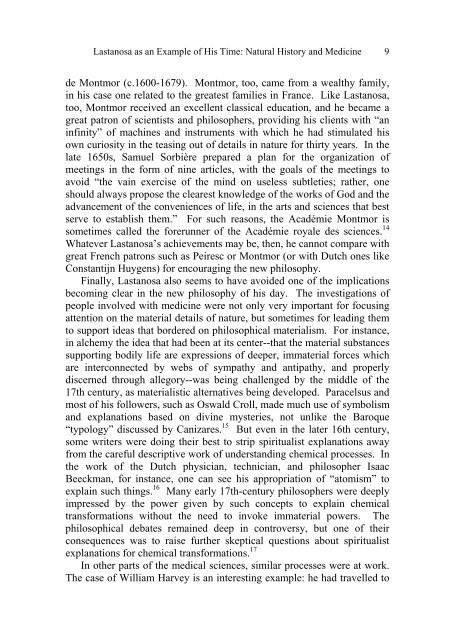The Gentleman, the Virtuoso, the Inquirer - Cambridge Scholars ...
The Gentleman, the Virtuoso, the Inquirer - Cambridge Scholars ...
The Gentleman, the Virtuoso, the Inquirer - Cambridge Scholars ...
Create successful ePaper yourself
Turn your PDF publications into a flip-book with our unique Google optimized e-Paper software.
Lastanosa as an Example of His Time: Natural History and Medicine<br />
de Montmor (c.1600-1679). Montmor, too, came from a wealthy family,<br />
in his case one related to <strong>the</strong> greatest families in France. Like Lastanosa,<br />
too, Montmor received an excellent classical education, and he became a<br />
great patron of scientists and philosophers, providing his clients with “an<br />
infinity” of machines and instruments with which he had stimulated his<br />
own curiosity in <strong>the</strong> teasing out of details in nature for thirty years. In <strong>the</strong><br />
late 1650s, Samuel Sorbière prepared a plan for <strong>the</strong> organization of<br />
meetings in <strong>the</strong> form of nine articles, with <strong>the</strong> goals of <strong>the</strong> meetings to<br />
avoid “<strong>the</strong> vain exercise of <strong>the</strong> mind on useless subtleties; ra<strong>the</strong>r, one<br />
should always propose <strong>the</strong> clearest knowledge of <strong>the</strong> works of God and <strong>the</strong><br />
advancement of <strong>the</strong> conveniences of life, in <strong>the</strong> arts and sciences that best<br />
serve to establish <strong>the</strong>m.” For such reasons, <strong>the</strong> Académie Montmor is<br />
sometimes called <strong>the</strong> forerunner of <strong>the</strong> Académie royale des sciences. 14<br />
Whatever Lastanosa’s achievements may be, <strong>the</strong>n, he cannot compare with<br />
great French patrons such as Peiresc or Montmor (or with Dutch ones like<br />
Constantijn Huygens) for encouraging <strong>the</strong> new philosophy.<br />
Finally, Lastanosa also seems to have avoided one of <strong>the</strong> implications<br />
becoming clear in <strong>the</strong> new philosophy of his day. <strong>The</strong> investigations of<br />
people involved with medicine were not only very important for focusing<br />
attention on <strong>the</strong> material details of nature, but sometimes for leading <strong>the</strong>m<br />
to support ideas that bordered on philosophical materialism. For instance,<br />
in alchemy <strong>the</strong> idea that had been at its center--that <strong>the</strong> material substances<br />
supporting bodily life are expressions of deeper, immaterial forces which<br />
are interconnected by webs of sympathy and antipathy, and properly<br />
discerned through allegory--was being challenged by <strong>the</strong> middle of <strong>the</strong><br />
17th century, as materialistic alternatives being developed. Paracelsus and<br />
most of his followers, such as Oswald Croll, made much use of symbolism<br />
and explanations based on divine mysteries, not unlike <strong>the</strong> Baroque<br />
“typology” discussed by Canizares. 15 But even in <strong>the</strong> later 16th century,<br />
some writers were doing <strong>the</strong>ir best to strip spiritualist explanations away<br />
from <strong>the</strong> careful descriptive work of understanding chemical processes. In<br />
<strong>the</strong> work of <strong>the</strong> Dutch physician, technician, and philosopher Isaac<br />
Beeckman, for instance, one can see his appropriation of “atomism” to<br />
explain such things. 16 Many early 17th-century philosophers were deeply<br />
impressed by <strong>the</strong> power given by such concepts to explain chemical<br />
transformations without <strong>the</strong> need to invoke immaterial powers. <strong>The</strong><br />
philosophical debates remained deep in controversy, but one of <strong>the</strong>ir<br />
consequences was to raise fur<strong>the</strong>r skeptical questions about spiritualist<br />
explanations for chemical transformations. 17<br />
In o<strong>the</strong>r parts of <strong>the</strong> medical sciences, similar processes were at work.<br />
<strong>The</strong> case of William Harvey is an interesting example: he had travelled to<br />
9

















